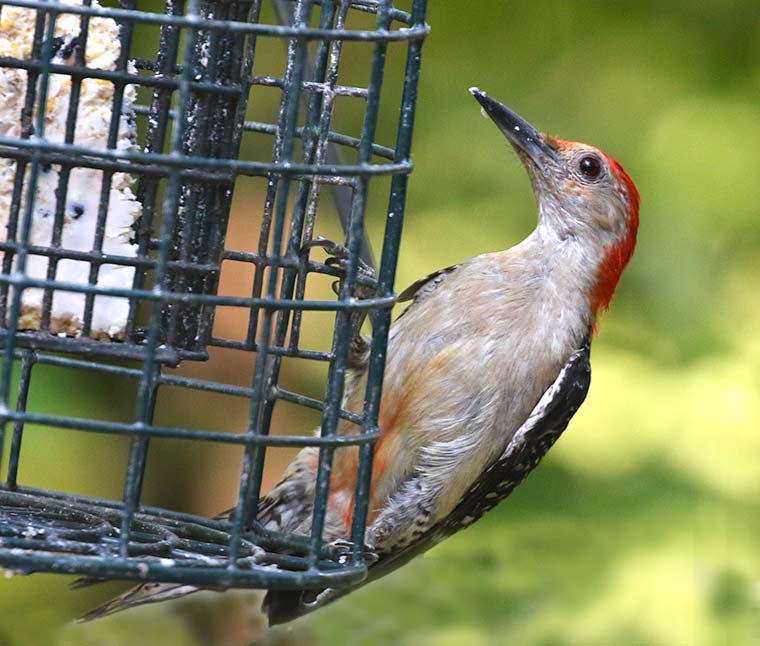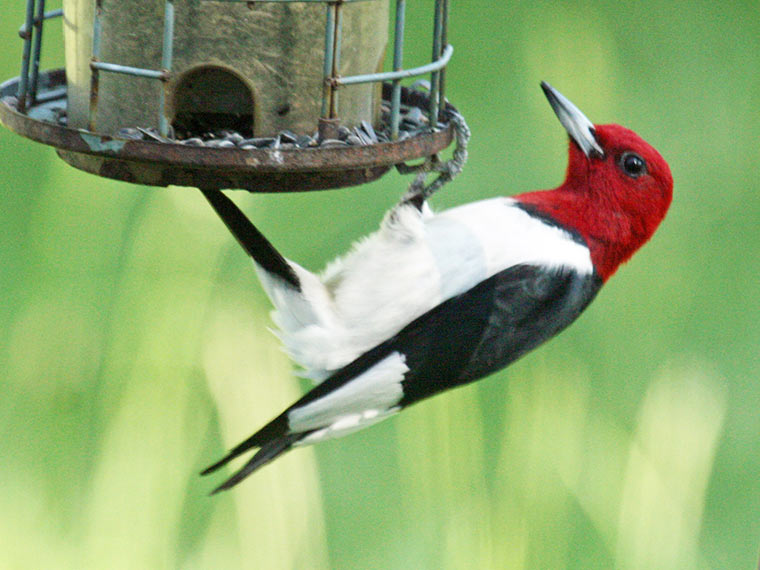This photograph shows one of the most common woodpeckers in our area visiting our suet feeder. At first glance, one would think that the common name for this species would be “Red-headed Woodpecker”. After all, one of the most prominent things about this bird is the bright red stripe on its head and neck. But the common name of this species is “Red-bellied Woodpecker”.
Linnaeus gave this bird its scientific name in his 1758 book Systema Naturae. This was the first time that modern binomial nomenclature was applied to animals. Binomial nomenclature means that the scientific name of the species has two parts…the genus and the species. For example, the scientific name for humans is Homo sapiens. For his 1758 work, Linnaeus had several woodpecker species that he wanted to provide with scientific names. Among these was the Red-bellied Woodpecker.
Linnaeus’ description of the Red-bellied Woodpecker (translated from the Latin original) is “Woodpecker with red cap and nape, back with black bands, central tail feathers white with black spots. Anal region spotted red.” You can see the reddish area around the anus of this bird. Unfortunately, when the bird is hitching its way up a tree, as woodpeckers are prone to do, the red belly cannot be seen, which causes people to wonder why its common name is Red-bellied Woodpecker.
In his 1758 work, Linnaeus had a related woodpecker specimen that he also needed to name. This was the species shown below, which we now call the “Red-headed Woodpecker”*. (Linnaeus did not give the two species common names, only scientific names.) He called the Red-Headed Woodpecker Picus erythrocephalus, The species name “erythrocephalus” means “red-head” from Greek erythros=red and kephalos=head. The one we now call the Red-bellied Woodpecker, he named Picus carolina. The species name “carolina” just means the specimen was collected in Carolina. I think you will agree that the Red-headed Woodpecker has a more spectacular red head than the Red-bellied Woodpecker, and it deserves its common name.
The “Picus” part of the name given by Linnaeus has its origin in Roman mythology. As told in The Metamorphoses by Ovid, Picus was the young king of Latium, a kingdom which preceded the Roman Empire on the Italian peninsula. Picus was exceedingly appealing to the fairer sex, and women went to great lengths to attract his favor. However, he loved only the nymph Canens, and they married.
One day when Picus was out hunting with a number of his attendants, he was spotted by Circe. (You remember her, the sorceress who turned some of Ulysses’ men into pigs when they stopped to visit her on their way back from Troy, as related in The Odyssey.) She tried to seduce Picus, but he remained faithful to his wife Canens and spurned Circe. It is not generally a good idea to spurn powerful sorceresses. Circe turned Picus into a woodpecker and turned his attendants into a variety of wild beasts. Canens searched for Picus, but failing to find him, died of grief. The word Picus became a Latin term for woodpecker, and Linnaeus used it in naming some species of woodpecker.
There are still a number of woodpecker species in the genus Picus, but unfortunately for our narrative, scientists have taken the Red-bellied Woodpecker and the Red-headed Woodpecker out of the genus Picus and placed them in the genus Melanerpes. Thus we now have Melanerpes carolina and Melanerpes erythrocephalus. Melanerpes means “black creeper” in Latin. I liked Picus better.
*I don’t have a good photograph of my own of a Red-headed Woodpecker, so the image I am using was lifted from the internet. It is an image by Dick Daniels. He has an excellent web site called “Birds of the World, An On-line Bird Book “; you can see it at http://carolinabirds.org. I am using the image under the Creative Commons Attribution-Share Alike 3.0 unported license.
Discover more from A Naturalist's Journal
Subscribe to get the latest posts to your email.



We used to have lots of Red Heads here, years before Mike and Krista moved here. One summer we had five at a time at our feeder! But they are long gone. I guess the environment here, too many homes? Not enough good trees? caused them to move on. We have Red-Bellied, Downy and Hairy now. Fun to watch.